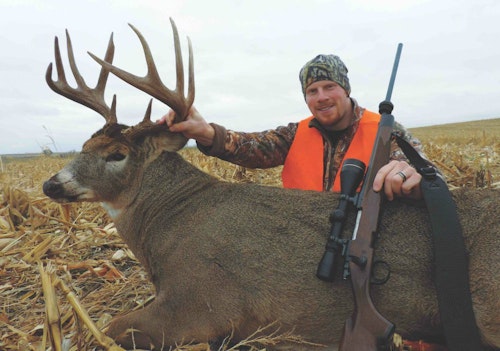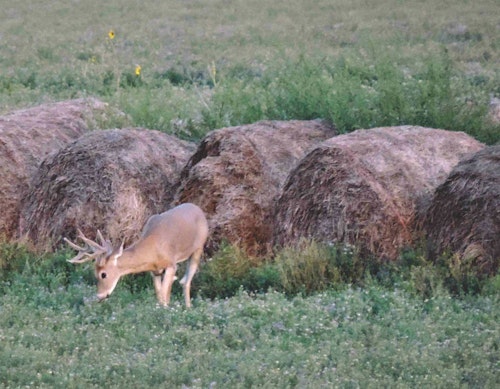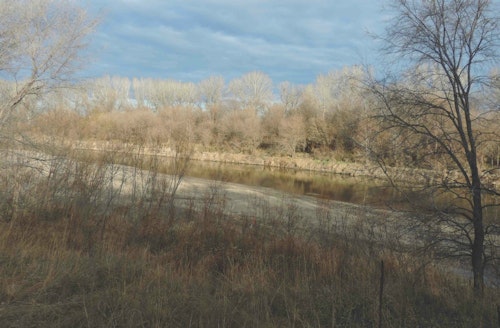Last summer when my wife answered questions about me for the 16 Personalities test, the results revealed my personality as “Adventurer.” I guess she knows me quite well. Aside from things that require my unwavering commitment and dedication — God, family and my writing career — I have a free-spirited side.
Understand, I’m not the stereotypical free-spirited person who smokes pot occasionally and lives out of a VW Beetle. Far from it. My free-spiritedness takes me to far-flung destinations to hunt whitetails. I’m not as well-traveled as some folks, but I’ve hunted whitetails in nine states already. Lord willing, I’ll hunt many more states over the next several decades.
If you feel the same inner longings for whitetail adventure as me, there are opportunities just waiting to be had. Of course, we’d all love to hunt Iowa every year, but reality is that pulling a premium Iowa tag requires a few years of building preference points. Good news: Various states offer over-the-counter (OTC) whitetail tags. And while you likely won’t encounter the same age class and antler quality in these states as in Iowa, work hard and you can experience a topnotch hunt nonetheless. Best of all, you can plan a hunt in most of these states on a dime.
Without further ado, let’s review five DIY hunts that I’ve done over the years. Find one that suits your fancy, and you can make it your own DIY mission.
1. North Dakota
In North Dakota, a bowhunter can arrive, purchase an inexpensive over the counter (OTC) deer tag and go hunting the same day. A small percentage of the state’s acreage is open to public hunting, but don’t be discouraged. Numerous public hunting opportunities exist across the Peace Garden State. These range from state wildlife management areas (WMAs) to national wildlife refuges (each refuge has its own details/regulations) to Bureau of Land Management (BLM) lands to U.S. Forest Service lands to state forest service lands to U.S. Army Corps of Engineers lands.
According to Bruce Dillings of North Dakota’s Game and Fish Department, “three WMA tracts worth considering are the Lewis and Clark WMA with 1,215 acres, the Killdeer Mountains WMA with 7,050 acres, and the Lonetree WMA with 32,890 acres. Hunting pressure varies on North Dakota’s public hunting lands, but, generally speaking, the farther you travel from large population centers, the less pressured deer will be.”
North Dakota’s archery season opens a month earlier than states such as Ohio or Iowa, offering solid chances at late-summer bachelor-buck groups. With an August 31 opener this year, bowhunters will also likely be hunting velvet-clad bucks during opening week.
To boot, North Dakota bowhunters enjoy very decent success rates. “Current archery-success rates range from 30 to 40 percent,” Dillings said. “Whitetails are plentiful on North Dakota’s public lands, and while some giants are annually taken, arrowing a mature North Dakota buck, like anywhere in the country, is a difficult, yet achievable task.”
Ruthless winters from 2008-2010 impacted the deer herd, which has rebounded nicely since. “The highest concentrations of whitetails are in the timbered river-bottoms throughout the state,” Dillings said. “In September, hay fields are generally the preferred food source. During the pre-rut and beyond, corn and sunflower fields seem to attract lots of deer.”
Hunters who don’t punch their North Dakota deer tag early can return for a second go-around, be it during the rut or late season. In the coldest temperatures, the biggest bucks will rise and move toward food sources during daylight. And, if it’s cold enough, you might be the only bowhunter for miles.
North Dakota Game and Fish Department
CONTACT: (701) 328-6300; www.gf.nd.gov
2. Oklahoma
Mild winters, excellent habitat and solid nutrition are reasons why Oklahoma produces excellent whitetail hunting. Another factor is its map location — it’s situated between Kansas and Texas, both big-buck factories.
Oklahoma offers a lengthy 3.5-month archery season, which opens October 1 and closes January 15. If muzzleloading is your forte, you can tote the front-stuffer during the pre-rut, with the season running October 27 through November 4.
Deer licenses are inexpensive, and bowhunters may take up to six deer, two of which may be antlered. The muzzleloading hunter can take a limit of one antlered deer and two antlerless deer, and these apply to the six-deer season limit if you plan to hunt with multiple weapons.
Oklahoma ranks number 5 of all whitetail states for buck age class. QDMA’s 2017 Whitetail Report denotes that 60 percent of all whitetail bucks harvested in 2015 were 3.5 years old or older. This alone makes the Sooner State a must-visit for the traveling bowhunter.
While hunting Oklahoma’s public lands, I’ve encountered my share of other hunters, but I’ve also encountered several shooter bucks, the largest pushing 170 inches. He never presented a shot, but I did tag a stout 150-incher during that same trip — my largest public land buck to date.
The Oklahoma Department of Wildlife Conservation’s Emily Clark shared that Oklahoma’s public lands account for merely 2 percent of the state’s acreage. Still, that number constitutes approximately 920,000 acres of public land — plenty of room to stretch your legs.
“Southeast Oklahoma’s richer soils and denser timber produce some of the state’s finest whitetail hunting,” Clark shared. “In particular, the Three Rivers and Honobia Creek WMAs offer high deer populations, and some wall-hanger bucks can be had.”
Many of Oklahoma’s wildlife management areas (WMA) are cultivated with soybeans and other deer necessities. Concentrate on hunting areas featuring a mix of food, cover and water, and you’ll find deer. In years with abundant acorns, hunt the timber hard because deer will rarely leave the food and security cover. Plus, many hunters sit field edges and other easy-access spots. Evade the pressure by hiking a mile or deeper, but don’t forget travel routes near roads that other hunters overlook, especially during the rut when a monster is liable to cruise any suitable travel route.
Oklahoma Department of Wildlife Conservation
CONTACT: (405) 521-3851; www.wildlifedepartment.com
3. South Dakota
At first glance, South Dakota’s vast, desolate prairies appear to be less-than-ideal deer habitat. A closer look reveals otherwise. I’ve taken two good bow bucks on public lands and a nice bow buck and stud rifle buck on private lands, plus several does with the bow.
South Dakota offers diverse deer habitat. The eastern half leading up to the Missouri River is rolling prairie with shelterbelts and timbered river-bottoms surrounded by booming acreages of crops including corn, beans and sunflowers. The east and west banks of the Missouri River are surrounded by rugged terrain breaks with deep canyons. West of the Missouri River, you’ll find more rolling prairies before reaching the broken Badlands. Finally, the Black Hills way out west consist of rock outcroppings and towering ponderosa pines.
The largest bucks annually come from central and eastern sectors, while the Black Hills holds its own for sheer numbers. Despite major EHD outbreaks on and off since 2011, South Dakota hunters continue to enjoy sound whitetail opportunities.
Hunters can stretch their legs on the state’s numerous Walk-In Areas, Game Production Areas and forest service lands. I’ve encountered other hunters occasionally, but by no means have I ever felt crowded while hunting the Mount Rushmore State. Indian reservations (learn more by calling each reservation headquarters) are another possibility, though you’ll likely need to hire a guide.

Bowhunters can obtain an archery license without first obtaining preference points. Simply submit a statewide archery deer-license application online or by mail, and several days later it will arrive in your mailbox. The license is valid statewide with few exceptions, plus, if a mule deer walks out that you want to harvest, let your arrow fly.
Firearms licenses are tougher to obtain. Most units require one or more preference points, which will require some research on your part along with a possible few-years wait. If you draw a firearms whitetail tag, you’ll extend your range substantially, which is never a bad thing.
South Dakota Game, Fish and Parks
CONTACT: (605) 223-7660; www.gfp.sd.gov
4. Nebraska
If you want to detach from hunting pressure, Nebraska is worth considering. Every Nebraska hunting trip I’ve taken has treated me to dozens of deer sightings. On one particular evening while scouting prior to a muzzleloader hunt, I counted more than 100 deer within 1 square mile, many of them on public land.
Trophy potential is certainly there, too. According to Nebraska’s Big Game Program Manager Kit Hams, “about 35 percent of Nebraska bucks harvested are 3.5 years old or older. Our age structure is holding up well. We manage for quality, not quantity.”
Hams reported that the state’s deer herd peaked back in 2010 when the whitetail buck harvest tallied approximately 38,000 animals. As the result of EHD for a few consecutive years following the 2010 peak, the Cornhusker State’s deer herd plummeted, as did buck harvest. In 2014, only 28,000 bucks were harvested statewide — the least by far in recent years. But, harvest numbers are on the mend and rising, meaning the deer population is near the state’s objective.
Nebraska offers many public land hunting opportunities. “Harlan County Reservoir is probably one of our best public hunting locations,” Hams said. “At least one third to maybe half of our deer harvest stems from that area, which consists of timbered river floodplain with several upland areas scattered throughout. Of course, there are many other public lands throughout the state that offer solid opportunities, too.”

Nebraska’s archery and muzzleloader deer licenses can easily be purchased at www.outdoornebraska.gov. Archery season runs September 1 through December 31, and muzzleloader season runs the length of December.
Nebraska Game and Parks
CONTACT: (402) 471-0641; www.outdoornebraska.gov
5. Kansas
Many Kansas deer units can be drawn without a preference point, but if you don’t pull a tag in the drawing, leftovers are generally available for several units. Although Kansas has gained great fame from outdoor media, which has increased hunting pressure, it’s still Kansas. You never know what will walk by your stand.
While the Sunflower State offers several hundred wildlife areas (WA) within its borders, some of the best hunting can be sniffed out on nearly 1 million acres of scattered Walk-In Hunting Areas, some of which are open to archery-only hunting.
Of course, hardworking Kansas hunters can experience high-quality hunting on WAs and Walk-In Hunting Areas alike. Mike Miller, chief of information with the Kansas Department of Wildlife, Parks & Tourism, said “public land bowhunters do best on WAs with reservoirs and riparian habitat. Get away from the large population centers, and you’ll experience less hunting pressure. Multiple WAs with several reservoirs in a 40-mile radius of Emporia offer good hunting opportunities, but good-quality hunting can be had statewide.”
Miller also shared that wise hunters who put in their time can reasonably expect to encounter 140-class or larger whitetail bucks on public lands, although killing one is far from easy. “Bowhunters seem to be fairly selective here, so the age structure of our herd is healthy,” he said. “Nonresident hunters will do best to select a few parcels to focus on. Having back-up options is always wise.”

Land of Oz bucks reach an older age class due to limited tag numbers, and the fact that Kansas’ firearms season lands well after the rut. A recent QDMA Whitetail Report, depicts that in 2014, 49 percent of harvested bucks were 3.5 years old or older. Another plus for the age structure is that all hunters are limited to one buck tag per season. In other words, you can only obtain a bow tag or a gun tag, not both.
Kansas Wildlife, Parks & Tourism
CONTACT: (620) 672-5911; www.kshuntfishcamp.com
Images by Darron McDougal







